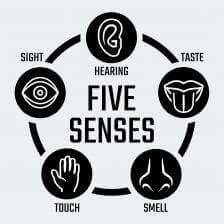What Is Sensory Processing Disorder (SPD)?
Affecting up to 16% of kids, Sensory Processing Disorder is the most common disorder you’ve never heard of. The Savvy Psychologist explains what is SPD and why it’s so misunderstood. Plus, answers to 3 big questions about the disorder.
Ellen Hendriksen, PhD
Listen
What Is Sensory Processing Disorder (SPD)?

A walk on a sandy beach feels like a forced march over broken glass. The sound of a blender makes you feel like you’re inside the engine of a 747. And all you can do is scream until it stops.
But at the same time, imagine turning the volume down so low that other sensory input can barely be perceived. You don’t even feel a tap on your shoulder, but you can register slamming into a wall, or a person. (There’s just the pesky fact that people get mad when you slam into them).
What’s more, when your brain constantly says “What just happened?” to whatever’s coming in, it can take a long time to settle down, get used to something, and focus. Therefore, transitioning to another activity once your brain is finally in a rhythm is maddening. For example, you just got the hang of this indoor lighting thing and now someone says you have to go outside in the sun. It’s totally overwhelming.
What Is Sensory Processing Disorder (SPD)?
Welcome to the neurological puzzle of Sensory Processing Disorder (SPD). Within each of us, a neurological process organizes the sensations that come into our bodies and allows us to respond in kind. But in kids and adults with SPD, that process is impaired.
And this, as Anchorman Ron Burgundy would say, is kind of a big deal.
Because what in our world can’t we see, hear, smell, taste, or feel? What isn’t presented as sensory information? Indeed, how we respond to something with our bodies, emotions, behaviors, or attention all depends on what sensory information comes in.

In general, symptoms of SPD fall into two broad categories: under-responsive and over-responsive. A great explanation I’ve heard is to imagine your processing ability is like a cup. You want your cup to be full, but not to overflow.
With any given sense, if you’re under-responsive, you have a really big cup. Each “drop” of sensory input doesn’t make much of an impact, so you have to keep filling and filling.
What Are the Symptoms of SPD?

On the flip side, if you’re over-responsive, you have a really tiny cup. Every “drop” of sensory input might overwhelm your cup and your cup overflows really easily. Using the pat on the hand example, my gentle pat might be neurologically interpreted as a sharp hit.
To make matters even more complicated, any given individual might have a different sized cup for each sense.
Your child, for example, may have a tiny cup for sound, and therefore may cover his ears and freak out when the vacuum turns on. At the same time, he may have a big cup for touch and therefore seem impervious to pain (unless it’s something like a broken arm).
Most kids with SPD are a mixture of both over- and under-responsive and sometimes a sensation that was avoided like the plague one day is actively sought out the next. The hallmark of the disorder is inconsistency.
To top it off, something called sensory modulation is also a challenge. This is the nervous system’s ability to prioritize some sensory input, like looking at and listening to the teacher, and downplay others, like the noise from the ceiling vent and that distracting fluorescent lighting.
These challenges, of course, are frustrating for folks with SPD, but they’re especially rough on parents and caregivers who don’t have a magic x-ray into the brain of their child. All they see is the kid screaming bloody murder over a string on their banana and then are perplexed by the same child’s endless need to roughhouse, spin, or swing.
In short, it’s a challenging disorder, compounded by the fact that it often gets labeled as something else (like autism or ADHD).
Does That Make Sense?

Proprioception is an ability to sense your body’s position in space. It allows you to execute full-body motions, like walking up stairs, or fine-motor movements like using a pencil or buttoning a button. Kids with proprioception difficulties may be accident-prone and have trouble with things like catching a ball or eating in a way that even approaches neatness.
Then, the vestibular system, found in the inner ear, senses movement and changes in the position of your head. An under-responsive vestibular system might cause a child to try to stimulate it by jumping or spinning (without ever seeming to get dizzy). On the flip side, kids with an overly-responsive vestibular system often seem fearful and clumsy on things like slides, swings, or stairs.
So there’s our quick and dirty intro to SPD. With that, let’s address 3 common questions about the disorder:
Question #1: If SPD is so common, why have I never heard of it before?
SPD is estimated to affect 5-16% of kids, which calculates to at least one in every classroom. But SPD is the Rodney Dangerfield of childhood disorders. Unlike autism and ADHD, it’s just starting to get press. It’s also the new kid on the block; it wasn’t until the early 1970s that Dr. A. Jean Ayres, an occupational therapist, identified and named the disorder.

But mostly, you’ve never heard of it because it’s not an official disorder. The American Psychiatric Association declined to include it in their most recent bible of disorders, the DSM 5 (but then again, the DSM doesn’t pretend to be perfect – many revisions ago, for example, it classified homosexuality as a disorder).
Also, the American Academy of Pediatrics has not yet recognized SPD as a separate diagnosis. They’re waiting for studies to prove that it is completely separate from, and not just a feature of, other disorders.
But things change fast. In 2013, researchers at UCSF found a neurological basis for the disorder. They found what they called “abnormal posterior white matter microstructure” in boys with SPD symptoms compared to matched controls. In other words, there were distinct differences near the back of the brain where connections between auditory, visual, and tactile systems are found.
Question #2: I don’t like labels in my shirt or crunchy cereals. Do I have SPD?

A related trait that’s not a disorder is high sensitivity. Between 15-20% of people are considered to be highly sensitive to sensory stimuli, like loud noise, rough fabrics, and subtle smells, but their neurological system isn’t jumbled, it’s just hyper-aware. Highly sensitive people are easily overwhelmed, but again, it’s a trait, not a disorder.
Check out Dr. Elaine Aron’s now-classic books, The Highly Sensitive Person and The Highly Sensitive Child if this sounds like you or your child.
Question #3: Can SPD be treated?
Yes!
Occupational therapists are the rock stars of treating SPD. In general, treatment consists of activities that challenge but don’t overwhelm the senses, with a goal to build and strengthen neural connections. Clearly, OT isn’t my field, so I won’t pretend to tell you how to treat SPD, but there are a bevy of good folks who can.
What I can tell you is that practice and repetition are key to build neural pathways that let a child respond more adaptively to sensory input, because today’s play dough squishing is tomorrow’s classroom pencil grip.
For more information and a more extensive list of symptoms, check out the SPD Foundation web site.
Do you have a child with SPD? How have you coped with the difficulties of the disorder? Share you story with us in Comments or on the Savvy Psychologist Facebook page.
References
Mitchell, A.W., Moore, E.M., Roberts, E.J., Hachtel, K.W., & Brown, M.S. (2015). Sensory processing disorder in children ages birth-3 years born prematurely: A systematic review. American Journal of Occupational Therapy, 69: 6901220030p1-6901220030p11. doi: 10.5014/ajot.2015.013755.
Owen, J.P., Marco, E.J., Desai, S., Fourie, E., Harris, J., Hill, S.S. et al. (2013). Abnormal white matter microstructure in children with sensory processing disorders. Neuroimage: Clinical, 2, 844-853.;
Tangled brain, pink shirt tag, and five senses images courtesy of Shutterstock.

